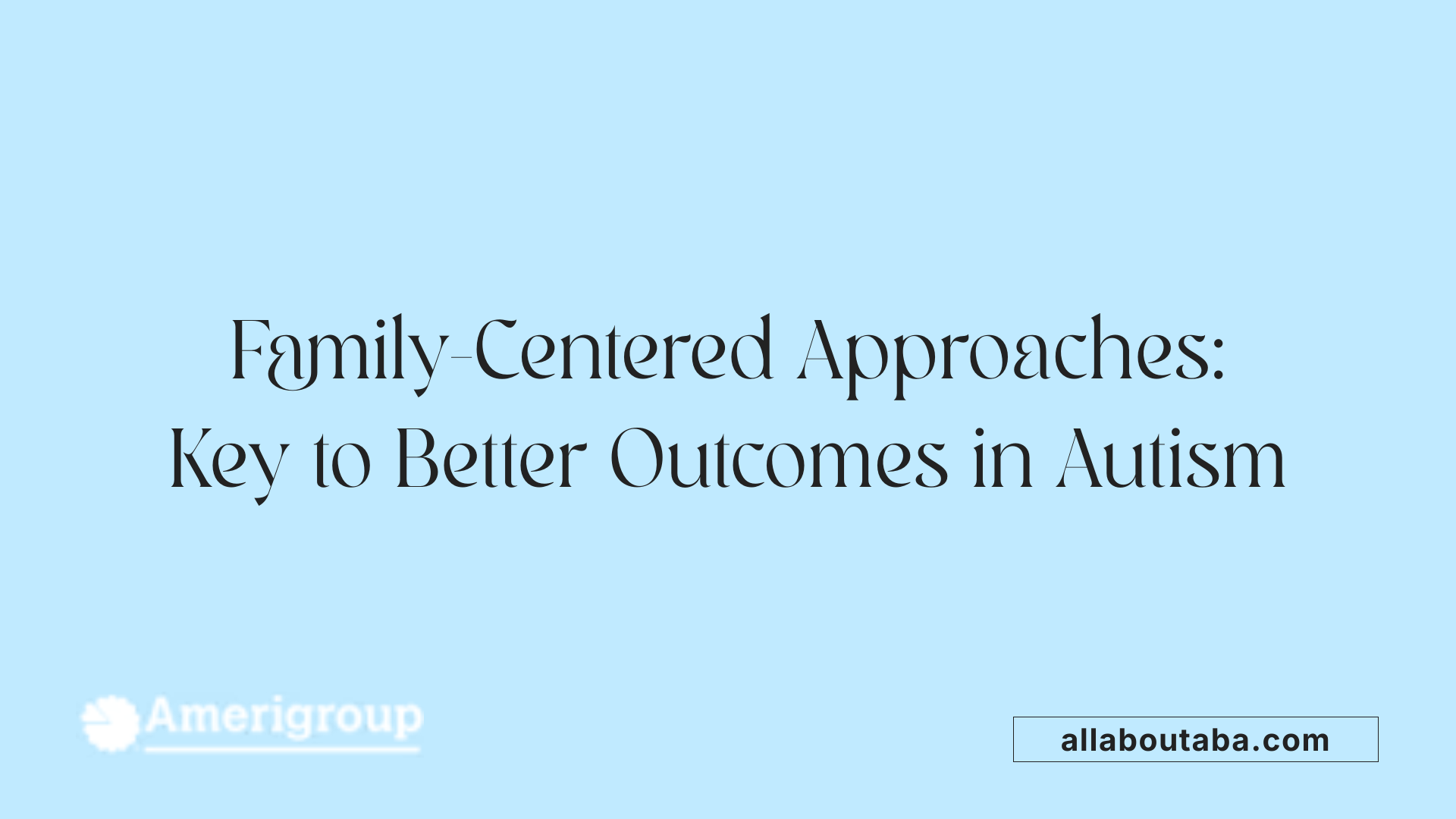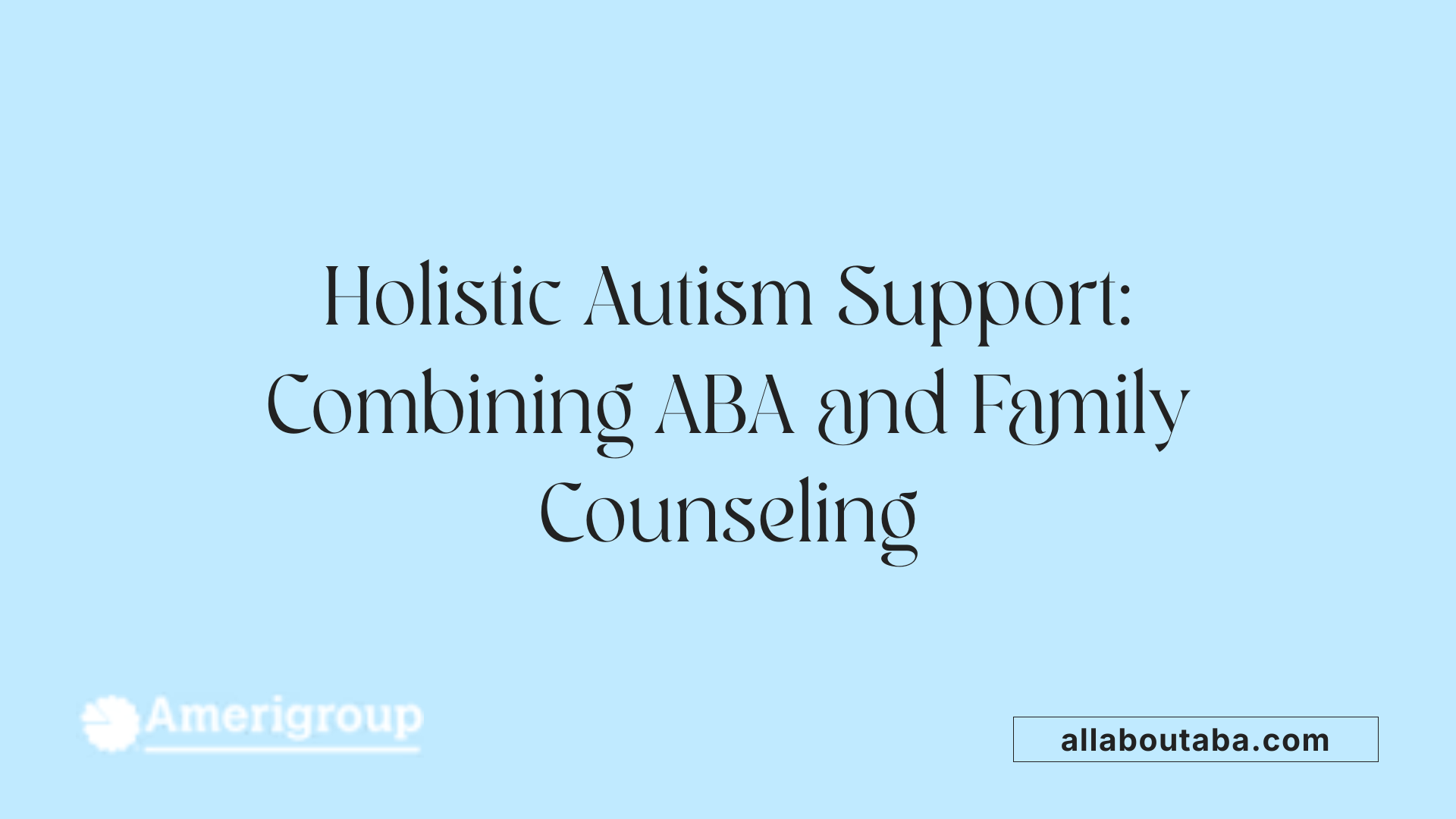Understanding the Impact of Autism on Family Dynamics
As autism diagnoses rise, impacting approximately 1 in 36 children, family households face unprecedented challenges. The unique behavioral and social needs of children with autism spectrum disorder (ASD) ripple through family interactions, creating stress and strain that can affect everyone. Family counseling emerges as a pivotal support mechanism, offering tailored strategies to improve communication, relationships, and coping within these households. This article explores how evidence-based therapies, particularly Applied Behavior Analysis (ABA), combined with family-focused counseling approaches, strengthen family dynamics and mental well-being for those navigating autism.
The Growing Need for Family-Centered Approaches in Autism Support

Rising Prevalence of Autism
Recent data from the CDC highlights a significant increase in autism spectrum disorder (ASD) diagnoses, now affecting approximately 1 in 36 children—a 22% rise from previous years. This trend underscores the escalating importance of comprehensive family support and tailored interventions to address the diverse needs associated with autism.
Family Impact and Stress
Families of children with ASD often face substantial emotional and social challenges. Elevated rates of mood disorders, marital strain, and increased risk of divorce are common among these family members. Parents experience persistent stress throughout different life stages due to barriers in accessing services, managing difficult behaviors, social isolation, and concerns over peer rejection. Such pressures profoundly affect family dynamics and overall wellbeing.
Importance of Family Therapy
While family therapy does not cure autism, it plays a crucial role in strengthening adaptive family relationships and enhancing communication. Approaches like Applied Behavior Analysis (ABA), Developmental, Individual Differences, Relationship-Based (DIR) model, and systemic therapies such as SAFE, support families in meeting autism-specific needs. These interventions encourage parental involvement, improve social and communication skills, and reduce challenging behaviors, fostering a supportive environment.
Family-centered therapies equip mental health professionals to provide psychoeducation about autism, mediate contrasting parenting styles, set healthy boundaries, and promote positive parenting techniques. Such strategies enhance cohesion and functioning within families, reducing stress and improving coping capacity amidst the challenges of autism.
| Aspect | Details | Significance |
|---|---|---|
| Autism Prevalence | 1 in 36 children diagnosed; 22% increase | Reflects growing public health concern |
| Family Stressors | Mood disorders, marital strain, social isolation, service access | Highlights urgent need for supportive interventions |
| Therapy Approaches | ABA, DIR, SAFE, family counseling | Supports communication, behavior management, family bonding |
| Benefits of Family Therapy | Improves communication, reduces parent stress, strengthens relationships | Enhances adaptive family dynamics and mental wellbeing |
Applied Behavior Analysis (ABA) Therapy: Foundations and Purpose

What is Applied Behavior Analysis (ABA) therapy and how is it used to support individuals with autism?
Applied Behavior Analysis (ABA) therapy is a science-based intervention focused on understanding and modifying behavior through learning principles. It examines how behaviors are influenced by environmental factors and uses strategies to encourage positive behaviors while reducing challenging ones.
ABA therapy helps individuals with autism by increasing essential skills such as communication, social interactions, and self-care. It also targets the reduction of behaviors that may cause difficulties, like aggression or tantrums.
The therapy process begins with a thorough assessment of a person's unique behavior patterns. Trained behavior analysts then create a personalized treatment plan that uses techniques like prompting, discrete trial training, and reinforcement schedules to shape desired behaviors.
Early intensive ABA interventions have shown strong developmental benefits. ABA's adaptability allows it to be tailored for each individual's specific needs and settings, including home, school, and community environments.
Scientific studies have consistently demonstrated that ABA improves language skills, social functioning, and overall adaptive behavior. This evidence-backed effectiveness has made ABA one of the most recognized therapies for supporting autistic children and young adults.
By focusing on measurable behavior changes and positive reinforcement, ABA provides a clear framework for helping individuals with autism build functional skills and greater independence.
Who Delivers ABA Therapy and How Are They Qualified?
Who typically provides ABA therapy and what qualifications do these professionals have?
ABA therapy is delivered by specialized professionals, primarily Board Certified Behavior Analysts (BCBAs) and Registered Behavior Technicians (RBTs). BCBAs generally hold advanced degrees in behavior analysis, psychology, or related fields. They must pass a rigorous certification exam and often obtain state licensure, ensuring they meet professional standards for developing effective, personalized treatment plans.
RBTs support therapy implementation under BCBA supervision. They acquire certification through comprehensive training, including coursework and supervised practical experience, which equips them to execute behavioral techniques accurately during therapy sessions.
How is family involvement integrated into ABA therapy?
Family members play a crucial role in ABA therapy. They are trained to reinforce therapy goals at home, fostering skill generalization and consistency in the child's environment. This collaborative approach strengthens not only the child's progress but also family dynamics, improving sibling interactions and parental understanding of therapeutic strategies.
By combining professional expertise with active family participation, ABA therapy becomes a well-rounded intervention tailored to meet the unique needs of autistic children and their families.
Techniques and Methods Employed in ABA Therapy
What are the common techniques and methods used in ABA therapy for autism?
Applied Behavior Analysis (ABA) therapy utilizes a variety of structured techniques to teach skills and reduce challenging behaviors in individuals with autism.
One major method is Discrete Trial Training (DTT), which breaks down complex skills into small, manageable tasks. Each task is presented repeatedly in a clear and controlled manner, providing opportunities for practice and mastery.
Modeling and prompting are also vital. Therapists or caregivers demonstrate desired behaviors for the child to imitate, while prompting offers guidance. Over time, prompts are gradually faded to encourage independent responses.
Reinforcement strategies play a crucial role by encouraging desirable behaviors. Positive reinforcement rewards good behavior with preferred stimuli, while negative reinforcement involves removing unpleasant stimuli when the desired behavior occurs. Different reinforcement schedules—such as continuous or variable ratio—are creatively employed to sustain motivation.
Natural Environment Teaching (NET) brings learning into everyday settings to generalize skills. Instead of structured trials, children learn through natural interactions, making skills more functional and meaningful.
Behavior chaining helps teach sequences of tasks by linking individual actions. Complex activities are broken into steps that are taught in order, allowing children to develop independence in daily routines.
Visual aids like pictures, charts, and videos support learning by clarifying expectations and enhancing communication. Techniques like script fading help with social skills, while behavior contracts define goals and rewards to boost motivation.
These methods are flexibly combined and tailored to each child's strengths and challenges, often incorporating siblings and family members to create a supportive learning environment that fosters communication, social skills, and emotional regulation.
Effectiveness of ABA Therapy in Autism Outcomes
How effective is ABA therapy in improving outcomes for individuals with autism?
Applied Behavior Analysis (ABA) therapy is widely recognized as a scientifically supported approach to enhancing outcomes for children with autism spectrum disorder (ASD). Research demonstrates that ABA therapy is effective in improving communication skills, such as through verbal behavior strategies, picture exchange communication systems (PECS), and the use of assistive technology.
Beyond communication, ABA promotes improvements in social skills including turn-taking, sharing, and perspective-taking, which help children better engage with peers and family members. Additionally, ABA techniques effectively reduce challenging behaviors like aggression, tantrums, and meltdowns by identifying and managing triggers.
ABA also supports emotional regulation, teaching children to recognize and control their emotions during difficult situations. This holistic behavioral intervention contributes to adaptive behavior gains that enhance daily functioning and independence.
Extensive research supports ABA as an evidence-based practice. Studies indicate that when ABA is applied early and with sufficient intensity, it can produce significant gains in language, social interaction, and behavioral management. It is also adaptable, allowing therapists to tailor strategies to the needs of each child and their siblings, fostering better family dynamics.
While ABA shows strong positive effects, there is some variability in outcomes influenced by factors such as the child's ASD severity and therapy implementation quality. Long-term effects continue to be studied, with ongoing research aimed at optimizing approaches for enduring benefits.
In summary, ABA remains a cornerstone therapy in autism treatment, effectively improving communication, social skills, and behavior, backed by robust clinical evidence and ongoing refinement.
Addressing Criticisms and Ensuring Compassionate ABA Therapy

What are some common misconceptions or criticisms of ABA therapy related to autism treatment?
ABA therapy, while scientifically backed and effective for many autistic individuals, faces several criticisms. Some common concerns stem from its historical implementation, where intense, repetitive drills risked producing over-structured or robotic behaviors. Critics worry that an excessive focus on compliance might overlook emotional well-being and restrict natural self-expression.
There's also debate about autonomy and dignity, with fears that children might be pressured to conform socially without consideration for their individual needs. Variability in therapist training means not all ABA interventions are delivered with the same quality or compassion, which can lead to less personalized and empathetic care.
Despite these concerns, modern ABA has evolved into a more compassionate practice. It integrates natural routines and emphasizes family involvement, understanding emotions, and tailoring therapy to each child's unique needs. By prioritizing communication and social skill development alongside positive behavioral support, contemporary ABA better respects individuality and promotes autonomy.
Ethical considerations play a crucial role in ensuring ABA respects the dignity of autistic individuals. Therapists are encouraged to maintain open dialogue with families, adjust strategies based on feedback, and promote self-advocacy within treatment. This ethical, individualized approach seeks to balance effective behavior management with compassionate care, addressing past criticisms while supporting positive outcomes.
The Role of Family Counseling in Supporting Autism Households
How Does Family Therapy Benefit Autism Households?
Family therapy, while not a cure for autism spectrum disorder (ASD), plays a crucial role in strengthening adaptive family dynamics. It helps improve communication among family members and supports the implementation of interventions tailored to each family's unique needs. This therapeutic approach promotes understanding, patience, and cohesion, which are vital in managing the daily challenges that come with autism.
In What Ways Can Communication and Relationships Be Improved?
Autism family therapy focuses on enhancing communication and building stronger relationships within the household. Techniques such as play therapy involving parents and siblings create natural, enjoyable learning environments that aid in the development of social, communicative, and emotional skills. Structured routines and positive reinforcement further support consistent interaction patterns, reducing stress and encouraging cooperation among family members.
What Coping Strategies Support Families Living with Autism?
Effective coping strategies taught in family-focused counseling include managing contrasting parenting styles, establishing clear boundaries, and developing time management practices to promote predictability and independence. These strategies help families navigate challenging behaviors and social issues such as peer rejection and service accessibility difficulties. Moreover, therapists facilitate the creation of social support networks, which are essential sources of emotional and practical assistance.
How Does Family Counseling Address Parental Mental Health?
Parents of children with ASD often experience elevated stress, anxiety, and depression due to ongoing challenges. Family counseling offers emotional support aimed at reducing these mental health risks. By fostering family cohesion and providing psychoeducation on autism's impact, counseling helps parents better understand and manage their experiences. Research highlights that such counseling significantly improves family dynamics and parental mental well-being, although continued study is encouraged to look at long-term benefits.
Integrating ABA Therapy with Family Counseling for Holistic Support

How Does Collaboration Enhance ABA Therapy and Family Counseling?
Effective support for children with autism spectrum disorder hinges on collaboration among caregivers, therapists, and educators. Regular communication, shared goals, and feedback loops ensure consistency in managing behavioral challenges, allowing families and professionals to work in unison towards a child's progress.
How Are Interventions Tailored to Meet Family Needs?
Both ABA therapy and family counseling emphasize individualized approaches. Evaluations identify each child's strengths and challenges, enabling treatments designed specifically for familial contexts. Therapists address differing parenting styles and provide psychoeducation on autism spectrum disorder impacts, customizing strategies that boost family cohesion and adaptive functioning.
In What Ways Are Siblings and Parents Involved in Therapy?
ABA therapy encourages parental involvement to reinforce skills taught during sessions, while siblings participate through structured activities like cooperative games and joint projects. This inclusion fosters understanding, patience, and supportive interactions, strengthening bonds among family members and improving social communication within the household.
How Does Shared Family Activity Enhance Cohesion?
Engaging families in shared, structured activities supports emotional regulation and creates positive experiences. Through play techniques and consistent routines, families promote predictability and reduce anxiety, while positive reinforcement encourages desirable behaviors. These shared efforts cultivate adaptive family dynamics, creating an environment where both children with autism and their family members thrive together.
Strategies to Foster Positive Family Dynamics in Autism Care
How do structured routines and predictability support families dealing with autism?
Structured routines and time management are critical strategies in autism care that help create predictability and reduce anxiety for both children and their families. By establishing consistent daily schedules, families can promote the child’s independence and provide a calming environment. Predictability in routines supports family cohesion by minimizing unexpected events that might trigger challenging behaviors.
What role does positive reinforcement play in autism management?
Positive reinforcement is a foundational technique in managing autism-related behaviors. Various reinforcement schedules—including continuous, fixed ratio, and variable ratio—are used to encourage desirable behaviors such as social interaction and emotional regulation. Implementing positive reinforcement consistently across home, therapy, and educational settings helps reinforce progress and strengthens adaptive behaviors.
How can play therapy and shared activities improve family interactions?
Play therapy, especially when involving parents and siblings, offers natural and enjoyable environments for children with autism to develop social, communicative, and emotional skills. Structured activities like cooperative games and joint projects foster positive shared experiences, enhancing bonding among family members. These shared activities also improve understanding and patience among siblings, leading to stronger relationships.
Why is building social support networks important for families?
Families affected by autism often face stresses such as social isolation and difficulties accessing services. Building strong social support networks—including connections with therapists, educators, and other caregivers—provides ongoing emotional support and knowledge sharing. Collaboration among these groups ensures consistent management of behavioral challenges and reduces parental stress and anxiety, thereby improving overall family well-being.
Building Resilient Families Through Counseling and Therapy
Family counseling combined with evidence-based therapies like ABA plays a critical role in supporting households affected by autism. These approaches not only address core behavioral and communication challenges but also help reduce parental stress, improve sibling relationships, and strengthen overall family cohesion. Continued research and integration of compassionate practices will further empower families to navigate the complexities of autism with resilience, understanding, and hope.
References
- Child Mind Institute | Transforming Children's Lives
- Supporting Families With Autistic Children
- Supporting Sibling Relationships in Autism Families Using ...
- Autism Family Counseling
- Who Qualifies for ABA Therapy: Eligibility Guide
- Applied Behavior Analysis (ABA)
- Applied Behavior Analysis (ABA)
- Applied Behavior Analysis (ABA)
- Introduction to Applied Behavior Analysis: ABA 101
- Applied Behavior Analysis in Children and Youth with Autism ...







